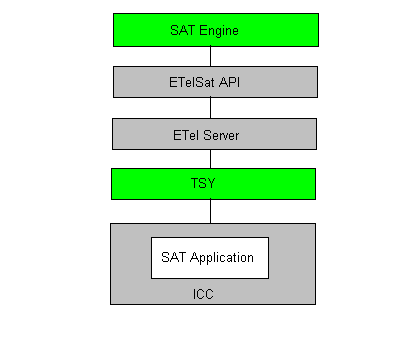Architecture
This section describes the architectural relationships of the SAT API.
The SAT API is a telephony system (TSY) extension module that interacts with the telephony server to perform different tasks. Normally the licensees implement the SAT clients and the TSY.
The TSY handles the messages between the SAT clients, telephony server and the toolkit application. All the TSY subsessions are derived from CTelObject. TSY responds with a CTelObject::ReqCompleted after the completion of a request and returns the handle to the client. Use asynchronous calls and active objects are used to prevent the threads from blocking other threads.
The server calls the ReqModeL() to find out the flow control mechanism implemented by the client. The TSY can control the flow when you calling the CTelObject::FlowControlSuspend() to stop the flow and CTelObject::FlowControlResume() to start a flow explicitly.
Description
SAT engine
The SAT client is a plug-in developed by the licensees to implement the toolkit functions. The SAT clients request proactive command notification by using RSat::Notifyxyz, where xyz represents one of the proactive command.
ETelSat API
ETelSat API provides the RSat interface and enables the SAT clients to request for proactive commands and multimedia proactive commands from the SAT application through the TSY. ETelSat API queues the notification request messages and responds to the SAT client when it receives the commands from ICC. It also passes back the response messages from the clients to the ICC.
TSY
The TSYs are usually developed by the licensees and are extension modules to the telephony server. They support the client side functionality by translating the messages to be implemented in the phone
SAT application
One or more SAT applications are stored in the ICC of the mobile device. They SAT application gets started as soon as the ICC is inserted in a SAT enabled phone. Once started, the application waits for request messages from the clients and responds to them accordingly. The SAT application is also responsible for security features like encryption, authentication of the messages between the phone and the network operator.
Copyright ©2010 Nokia Corporation and/or its subsidiary(-ies).
All rights
reserved. Unless otherwise stated, these materials are provided under the terms of the Eclipse Public License
v1.0.
